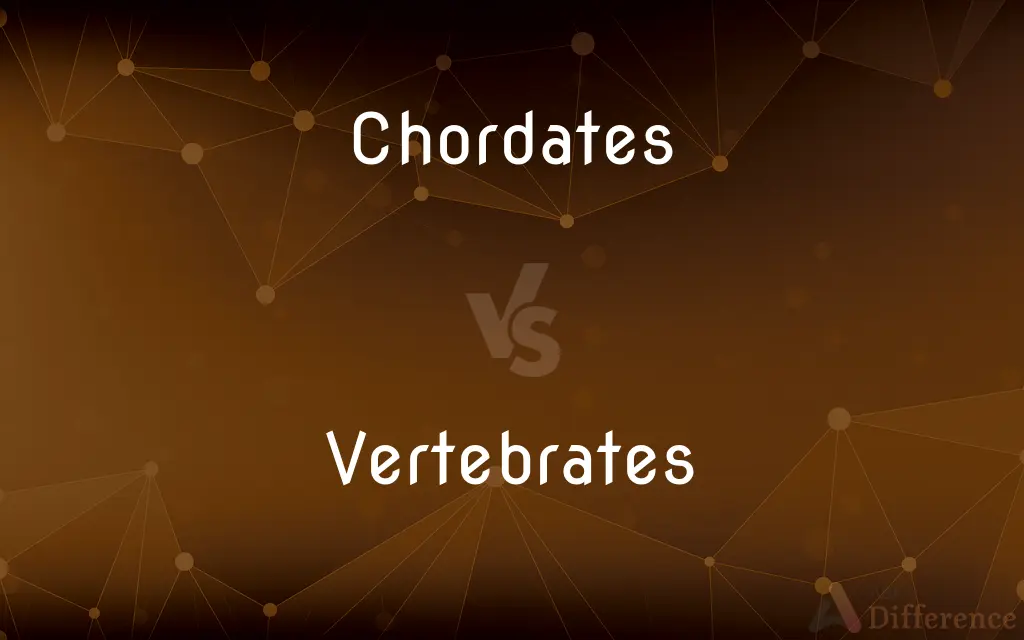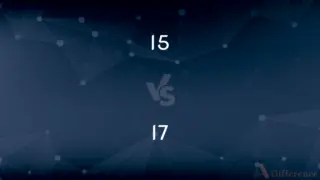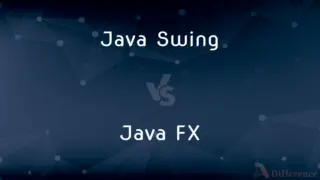Chordates vs. Vertebrates — What's the Difference?
By Tayyaba Rehman — Published on January 16, 2024
Chordates are animals with a notochord at some life stage, while vertebrates, a subgroup of chordates, have a spinal column or backbone.

Difference Between Chordates and Vertebrates
Table of Contents
ADVERTISEMENT
Key Differences
Chordates are a diverse group of animals distinguished by having a notochord, a hollow nerve cord, pharyngeal slits, and a post-anal tail at some stage in their life cycle. Vertebrates, a subset of chordates, are characterized by the presence of a vertebral column or backbone, which replaces the notochord during early development in most species.
The notochord in chordates provides skeletal support, a feature seen in all chordates including those without a vertebral column. In vertebrates, the notochord is replaced by a segmented spinal column during development, which provides greater structural support and protection for the spinal cord.
Chordates include both vertebrates (like mammals, birds, reptiles, amphibians, and fish) and invertebrates (such as tunicates and lancelets). Vertebrates are distinct for their well-developed internal skeleton and complex body systems.
In chordates, the nerve cord is dorsal and hollow, a unique feature in the animal kingdom. In vertebrates, this nerve cord develops into a complex central nervous system, including a brain encased in a skull.
In summary, while all vertebrates are chordates, not all chordates are vertebrates. The key distinction lies in the development of the vertebral column, which is present in vertebrates and absent in some other chordates.
ADVERTISEMENT
Comparison Chart
Defining Feature
Notochord present at some life stage
Vertebral column or backbone
Inclusivity
Includes vertebrates and some invertebrates
Subset of chordates with a spinal column
Skeletal Structure
Notochord provides skeletal support
Spinal column replaces notochord
Nervous System
Dorsal, hollow nerve cord
Complex central nervous system with a brain
Examples
Tunicates, lancelets, and all vertebrates
Mammals, birds, reptiles, amphibians, fish
Compare with Definitions
Chordates
Animals with a notochord, a dorsal nerve cord, pharyngeal slits, and a post-anal tail.
Lancelets are simple chordates without a backbone.
Vertebrates
A subgroup of chordates that have a well-developed internal skeleton.
Reptiles are cold-blooded vertebrates.
Chordates
Organisms characterized by having a notochord at any stage of their development.
Tunicates are marine chordates that lose their notochord as adults.
Vertebrates
Vertebrates encompass five major classes: fish, amphibians, reptiles, birds, and mammals.
Amphibians are vertebrates that live both in water and on land.
Chordates
Chordates include all animals with a spinal cord or notochord.
Humans are advanced chordates with a highly developed nervous system.
Vertebrates
Members of the animal kingdom characterized by a vertebral column.
Mammals are warm-blooded vertebrates with hair or fur.
Chordates
A diverse group in the animal kingdom that includes both vertebrates and certain invertebrates.
Chordates range from fish to mammals.
Vertebrates
Animals with a segmented spinal column or backbone.
Fish are the most diverse group of vertebrates.
Chordates
Members of the phylum Chordata, distinguished by specific developmental features.
Birds, as chordates, have a distinct embryonic development.
Vertebrates
Organisms with a complex nervous system including a brain encased in a skull.
Birds are vertebrates known for their ability to fly.
Chordates
Any of numerous animals of the phylum Chordata, having at some stage of development a dorsal nerve cord, a notochord, and gill slits and including all vertebrates, the hagfishes, and certain marine animals such as the lancelets and the tunicates.
Vertebrates
Having a backbone or spinal column.
Chordates
Plural of chordate
Vertebrates
Of or characteristic of vertebrates or a vertebrate.
Vertebrates
Any of numerous chordate animals of the subphylum Vertebrata, characterized by a segmented spinal column and a distinct well-differentiated head. The vertebrates include the fishes, amphibians, reptiles, birds, and mammals.
Vertebrates
Plural of vertebrate
Common Curiosities
What replaces the notochord in vertebrates?
In vertebrates, the notochord is replaced by a segmented spinal column.
Are all chordates also vertebrates?
No, not all chordates are vertebrates; some lack a vertebral column.
What are vertebrates?
Vertebrates are chordates with a backbone or spinal column.
What defines a chordate?
Chordates are defined by a notochord, dorsal nerve cord, pharyngeal slits, and a post-anal tail at some life stage.
What kind of nervous system do vertebrates have?
Vertebrates have a complex central nervous system with a brain.
Can chordates be invertebrates?
Yes, some chordates like tunicates and lancelets are invertebrates.
How do vertebrates differ in their skeletal structure from other chordates?
Vertebrates have a more complex and segmented skeletal structure with a spinal column.
Do all chordates have a brain?
Not all chordates have a well-developed brain; this is more specific to vertebrates.
Do chordates always retain their notochord?
No, in many chordates, the notochord is present only during embryonic development.
Is the notochord present in adult vertebrates?
In most vertebrates, the notochord is replaced by the vertebral column during development.
Are humans chordates or vertebrates?
Humans are both chordates and vertebrates.
Are all vertebrates mammals?
No, vertebrates include mammals, birds, reptiles, amphibians, and fish.
Are birds considered vertebrates?
Yes, birds are vertebrates with a backbone and a well-developed skeleton.
Do all chordates have a post-anal tail?
Yes, all chordates have a post-anal tail at some stage of their development.
What are the main classes of vertebrates?
The main classes are fish, amphibians, reptiles, birds, and mammals.
Share Your Discovery

Previous Comparison
I5 vs. I7
Next Comparison
Java Swing vs. Java FXAuthor Spotlight
Written by
Tayyaba RehmanTayyaba Rehman is a distinguished writer, currently serving as a primary contributor to askdifference.com. As a researcher in semantics and etymology, Tayyaba's passion for the complexity of languages and their distinctions has found a perfect home on the platform. Tayyaba delves into the intricacies of language, distinguishing between commonly confused words and phrases, thereby providing clarity for readers worldwide.
















































